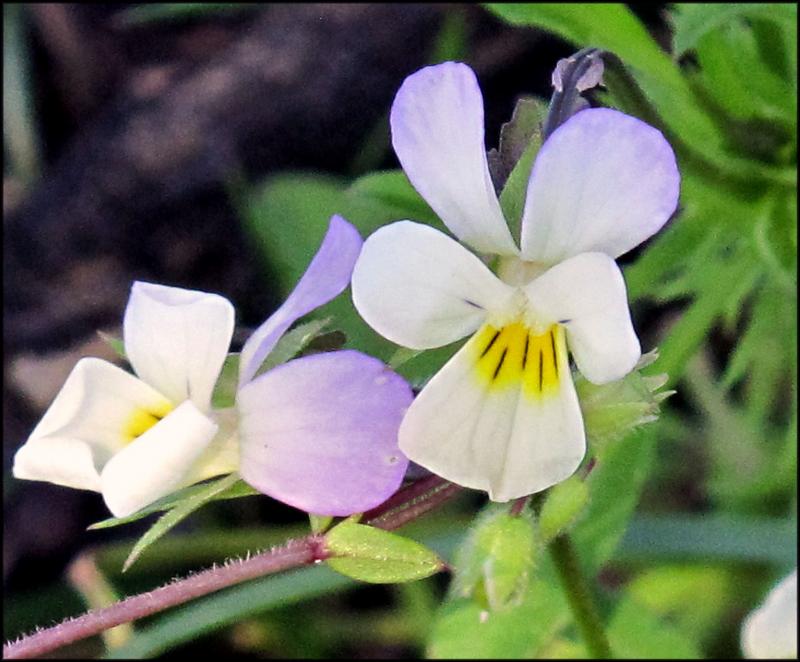The garden is popping with color – and flavor
In spite of the unsettled temperatures, from nearly freezing to the high 70s, flowers across the region are happily blooming. The tulips and daffodils have already faded, while azaleas, roses and peonies are popping with color. If you look carefully, you can find johnny-jump-ups and wild violets, as well as early geraniums and marigolds. With all that inspiration, why not consider cooking with some of those flowers?
This is certainly not a new idea. Thousands of years ago, Chinese and Roman chefs were adding flowers to their dishes. Dried day lilies (called “golden needles”) remain a popular ingredient in Chinese cuisine, along with chrysanthemum, lotus and hibiscus. From the Italian delicacy of stuffed squash blossoms to Middle Eastern and Indian dishes featuring roses, flowers can add so much color and flavor to the menu.
Some flowers, such as chive blossoms can add spicy notes, while the johnny-jump-up in the photo has a faintly wintergreen flavor. You can decorate cakes and cupcakes with tiny blossoms, and mix them into honey, simple syrup, salad dressings, pasta dough or ice cream. Tea sachets made from jasmine, rose and chamomile are widely available, and flower buds (such as nasturtium) can be pickled in brine.
Of course, there are a few caveats regarding edible flowers. First, be sure to confirm the species or varietal is safe to eat, checking the plant’s name with a reputable online source, such as www.whatscookingamerica.net. There are a number of books on the topic that vary in quality, but I would suggest Kathy Brown’s “Edible Flowers” as a good place to start.
The next question is where to source your edible flowers. The best place is your own garden, where you will know everything about their growing conditions. Flowers from a florist or nursery are likely to have been treated with pesticides. The same is true for roadside blooms, which will also have remnants of car exhaust. Public parks may seem an appealing source, but, again there’s no certainty about unwanted pollutants.
For some flowers, such as dandelions, the leaves are also edible, but for most, it’s safest to incorporate just the blossoms. You should remove the pistils and stamens in the center, eating only the petals. If you are prone to allergies, you may want to approach flowers with caution, trying them sparingly at the start, choosing a cooked recipe rather than a raw salad.
Try to pick the blossoms early in the day, while the dew is still damp and the flowers are freshest. Rinse them very lightly, so as to not damage the petals, shake them gently to remove droplets, and place them on moist paper towels in the refrigerator until ready to use. Now you’re ready to choose a recipe to feature your prize blossoms.
Scatter petals across lettuce leaves to brighten a salad, or toss them with steamed vegetables. This recipe for stuffed squash blossoms doesn’t fry the delicate beauties in oil, but bakes them to a deliciously crisp exterior around a creamy center. Faintly scented lavender rice is the perfect side dish for filet of sole or grilled chicken breast.
Crystallized edible flowers make beautiful decorations for desserts and can last up to one year in an airtight container.
Stuffed Squash Blossoms
8 squash blossoms
3/4 C ricotta cheese
2 t snipped chives
2 eggs
1/4 C grated Parmigiano-Reggiano
1/2 C panko bread crumbs
Preheat oven to 400 F. Line a baking sheet with parchment paper; set aside. Whisk together ricotta cheese, chives and one egg. Open blossom and remove the stamen. Stuff a tablespoon of the ricotta mixture into the heart of the flower. Twist the blossom closed and repeat with the remaining blossoms. Beat the other egg in a shallow bowl, and combine the bread crumbs and Parmigiano-Reggiano cheese on a sheet of waxed paper. Dip twisted flower in the egg and then roll in the bread crumb mixture to coat completely. Place the blossoms in a single layer on the prepared baking sheet. Bake until golden, about 15 minutes. Yield: 4 servings.
Lavender Rice
1 T butter
1 C jasmine rice
1 1/3 C vegetable stock
3-inch lavender stem with leaves
1/3 C chopped pecans
salt, to taste
Melt butter in a saucepan over medium. Stir in rice; add stock and lavender. When rice begins to boil, cover and reduce heat to low. Simmer for 20 minutes. Toast the pecans in a dry skillet until fragrant. Remove lavender stem and scoop rice into a serving dish; season to taste with salt and sprinkle with toasted pecans. Yield: 4 servings.
Crystalized Flowers
1 egg white
1/4 t water
superfine sugar
small edible flowers
Cover a drying rack with waxed paper; set aside. Cut flowers from stems as close to the base of the blossom as possible. Rinse gently, blot carefully and place on paper towels to dry completely. Beat the egg white and water in a small bowl until foamy. Hold the blossom with tweezers and use a small paint brush to coat each petal individually with egg white. Sprinkle the blossom with sugar, taking care to coat the entire petal. If sugar is absorbed, repeat the process. Place the coated flowers on the rack to dry at room temperature for at least 12 or up to 36 hours. When there is no moisture and the flowers are completely stiff and brittle, layer them between sheets of tissue paper in an airtight container.





















































